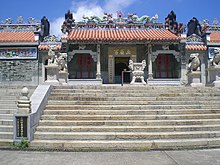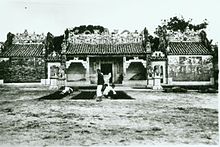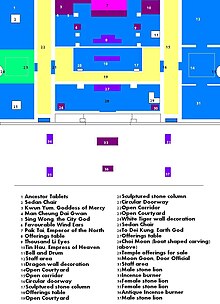Yuk Hui Gung
The Yuk Hui Gung (also: Pak Tai Miu ; Chinese 玉虛宮 / 北 帝 廟 , Pinyin yù xū gōng / bĕi dì miào ; English: Yuk Hui Temple / Pak Tai Temple; German: Palace of the Jade Void, Temple of Northern Lords of Heaven) is a Daoist temple on Cheung Chau Island in the Hong Kong area ⊙ . Annually, the Cheung Chau Bun Festival is held at the temple , which has become a tourist attraction.
The temple was included on the List of Grade I historic buildings in Hong Kong because of its importance to Cheung Chau . The Cheung Chau Bun Festival , a Daoist ritual, is celebrated every year at the temple. The festival begins on the 8th day of the fourth month of the lunar calendar , i.e. between April and May, alternating according to the Gregorian calendar . The festival lasts seven days and has become a tourist attraction, but it also attracts many worshipers of the god Hei di (Pak Tai).
history
The first settlers on Cheung Chau were fishermen from Huizhou , Guangzhou and Chaozhou . They worshiped the Saoist sea god Pak Tai. In 1777 a serious epidemic broke out on Cheung Chau. Legend has it that the plague disappeared when a Huizhounese brought a statue of Pak Tai to the island. In gratitude for Pak Tai's help, the residents, led by Lam Yuk-mo, built the temple, which was completed in 1783.
administration
In the beginning, the temple was looked after by volunteers and maintained by the local residents. Since 1929 the Chinese Temples Committee has taken over the supervision. The temple was renovated several times. Well-known construction works took place in 1822, 1838, 1858, 1903 to 1904 and 1989. The most recent began in 1999 and ended in 2003. It cost around 13 million HKD . Valuable antiques have been donated to the temple since its inception.
Deities
The main god of the temple is Pak Tai (Yuen Tin Sheung Tai, 玄天 上帝 ), the supreme ruler of the northern sky. In Taoist mythology, he was a prince of the Shang Dynasty and was commissioned by the Jade Emperor to fight the Demon King. He won the battle, although the Demon King summoned a gray turtle and a giant snake to help. After the victory, Pak Tai received the title Yuen Tin Sheung Tai . He is revered for his power, courage and devotion. In the depictions he usually stands on a turtle and a snake. This illustration symbolizes that good will always triumph over evil.
In the temple there are also images of Guanyin (Goddess of Mercy), Tai Sui (Sixty Gods of Time), Tin Hau , the old man under the moon (God of mediation and marriage) and Tu Di Gong ( God of Earth).
Local residents and fishermen are the main visitors. They come mainly on the various feast days to pray or to express gratitude for protection. In addition, favorable dates for weddings and important events are determined and prayers are said for a rich catch and for blessings.
The main festivals of the temple are the Pak Tai Festival on the third day of the third lunar month and the Cheung Chau Bun Festival (Tai Ping Ching Chiu) on the eighth day of the fourth lunar month.
architecture

The temple buildings are built according to the specifications of Feng Shui . The temple stands on the pulse of the dragon , with the ocean in view from the main entrance and the mountains of Hong Kong Island in the background. Probably because of its location, the temple is also the most popular temple on Cheung Chau. The traditional Chinese architectural style is evident in the roofing with green concave tiles, panes and ceramic figurines. Guardian lion figures are scattered throughout the temple and the temple is known for having the most stone lions of any temple in Hong Kong.
The main entrance leads to the main hall where the statue of Pak Tai is located. Smaller halls are added on either side of the main hall. The images of a white tiger and a blue dragon represent the power. The two side halls enhance the feng shui of the temple.
An old drum and bell (from 1784.) are to the left of the temple entrance to drive away evil spirits and to attract the attention of the gods.
Attractions
There are four lion figures at the main entrance . Two of the lions have balls in their mouths and it is said that unmarried girls who can take the balls will marry a prince. The two lions on the left of the entrance are lionesses with a cub by their side, while the lions on the right are male lions with a ball under their paws. Legend says that the balls contain milk.
In the middle of the hall are two stone pillars that were formed from a block of granite in 1903 and are shaped like dragons . They are imperial dragons with five claws on each foot. Ordinary dragons only have four claws. Another ball can be seen in the dragon's mouth, which is known as the dragon's pearl . Popular belief considers it a good omen for the dragon to let go of the pearl.
There are also angular stone pillars on which the inscription is attached: "Pak Tai will watch over Cheung Chau and will bring calm seas and good weather."
The iron sword is one of the most important treasures of the temple. It was made in the Song Dynasty about 800 years ago. Legend has it that it was thrown into the sea by a general of Emperor Song Bing to calm a storm. Years later, fishermen found it and gave it to the god.
There are two other legends: The first tells that during the Japanese occupation a Japanese soldier stole the sword and claimed it as property. Soon after, he died under mysterious circumstances. One of the soldier's friends believed the sword was the cause of his death and returned it to the temple. The second legend tells that the sword was stolen in the early 1970s. The villagers used the bwabway (筊 杯), an oracle of popular religion, to solicit Pak Tai's help. According to the oracle, the sword was in the east and would reappear on its own. Police later found it left behind in East Kowloon District . The clipping of a newspaper article about this case has been kept in the temple ever since.
The golden crown of the large Pak Tai statue is made of 20 ounces of gold and is hung with pearls. It was donated in 1966 by Madam Chung, a believer from Cheung Chau, on the occasion of the visit of Princess Margaret and the Earl of Snowdon .
More antiques
- An 1894 Sedan Chair used to transport the statue of Pak Tai;
- a pair of incense burners donated by the Chinese Temples Committee in 1960 to commemorate the 1959 visit by Claude Bramall Burgess , the Government Administrating Officer ;
- a stone cauldron from 1894;
Cheung Chau Bun Festival
The Cheung Chau Bun Festival is supported by the Hong Kong Tourism Board and attracts thousands of onlookers every year. The highlight of the festival is the Bun Snatching Race ( 搶包 山 pao bao shan), in which the participants climb three 60-feet high (18.3 m) bamboo towers with Chinese ping on buns (bao, dough balls) to get as high as possible climb and catch as many as possible.
gallery
Location of Cheung Chau in Hong Kong.
See also
There are other Yuk Hui temples :
- in Wan Chai (灣仔 北 帝 廟), Hong Kong
- in Zhang zhou (長 洲 北 帝 廟 / 玉虛宮)
Individual evidence
- ↑ youdict.com
- ↑ a b c d e f Chinese Temples Committee: Pak Tai Temple, Cheung Chau. 2008.
- ^ A b P. W. Leung: Heritages of the Islands District Hong Kong. The Islands District Council, Hong Kong 2007, p. 129.
- ^ PW Leung: Heritages of the Islands District Hong Kong. The Islands District Council, Hong Kong 2007, pp. 130-131.
- ↑ a b c d e Temple Directory. Temples Unit, Trust Funds Section, Home Affairs Dept, Hong Kong 1980.
- ↑ L. Bai: Xiaozai Qiushen Dashidian. Jia Chu Ban, Hong Kong 2004.
- ↑ a b c d e f g R. F. Cooper: Temple of the Jade Vacuity. Welcome to Hong Kong Temples. Book Marketing, Hong Kong 1977, pp. 81-88.
- ↑ a b c S. Y. Chan: Cheung Chau Yuk Hui Temple. 2002. (fushantang.com)
- ↑ Hong Kong Tourism Board: Cheung Chau Island Tour - Pal Tai Temple . 2009.
- ^ Asia Web Direct: Cheung Chau Attractions - Pak Tai Temple . 2009. (hong-kong-hotels.ws)
- ↑ a b K. Raby: Hong Kong Temples. Allion Printing Company, Hong Kong 2005.
- ↑ a b c G. D. Yin: Ru Miao Bai Shen. Cognizance Publishing Company, Hong Kong 2009.
- ^ Y. Tian: Qi Miao. Ciwenhua, Hong Kong 2004.
Web links
- Cheung Chau Island on the Hong Kong Tourism Board homepage
- Yuk Hui Temple on the homepage of the Chinese Temples Committee
Coordinates: 22 ° 12 ′ 45 ″ N , 114 ° 1 ′ 40 ″ E









